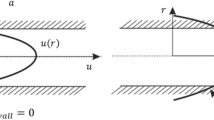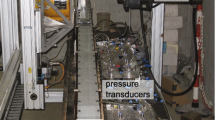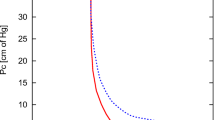Abstract
In this study, non-Darcy inertial two-phase incompressible and non-stationary flow in heterogeneous porous media is analyzed using numerical simulations. For the purpose, a 3D numerical tool was fully developed using a finite volume formulation, although for clarity, results are presented in 1D and 2D configurations only. Since a formalized theoretical model confirmed by experimental data is still lacking, our study is based on the widely used generalized Darcy–Forchheimer model. First, a validation is performed by comparing numerical results of the saturation front kinetics with a semi-analytical solution inspired from the Buckley–Leverett model extended to take into account inertia. Second, we highlight the importance of inertial terms on the evolution of saturation fronts as a function of a suitable Reynolds number. Saturation fields are shown to have a structure markedly different from the classical case without inertia, especially for heterogeneous media, thereby, emphasizing the necessity of a more complete model than the classical generalized Darcy’s one when inertial effects are not negligible.
Similar content being viewed by others
Abbreviations
- A :
-
Section of the medium, m2
- Ca κ :
-
κ-Region capillary number
- d :
-
Grain size, m
- f α :
-
Fractional flow for the α-phase
- g :
-
Gravitational acceleration, m s−2
- I :
-
Unit tensor
- K :
-
Intrinsic permeability tensor (= k I for an isotropic case), m2
- K α :
-
α-Phase effective permeability tensor, m2
- k κ :
-
Intrinsic permeability in the κ-region, m2
- k r α :
-
Relative permeability tensor for the α-phase (= k r α I for an isotropic case)
- l :
-
Characteristic scale of the problem, m
- L :
-
Length of the medium, m
- M :
-
Total mobility tensor (= M o + M w ), m3 kg−1 s
- M α :
-
α-Phase mobility tensor (= M α I for an isotropic case), m3 kg−1 s
- N :
-
Number of grid blocks
- n e :
-
Unit vector normal to the outlet face
- n i :
-
Unit vector normal to the inlet face
- n l :
-
Unit vector normal to the lateral surfaces
- n ω η :
-
Unit vector normal to the ω–η interface pointing from the ω-region toward the η-region
- p :
-
Fluid pressure for one-phase flow, Pa
- p atm :
-
Atmospheric pressure, Pa
- p α :
-
α-Phase pressure, Pa
- p 0 :
-
Initial oil-phase pressure, Pa
- p c :
-
Capillary pressure, Pa
- p c0 :
-
Maximum capillary pressure at S w = S wi, Pa
- \({p_{c}^{\kappa}}\) :
-
Capillary pressure in the κ-region, Pa
- q :
-
Flow rate of water injected at the inlet of the medium, m3 s−1
- r :
-
Position vector, m
- r e :
-
Position vector relative to the outlet face, m
- Re :
-
Reynolds number
- Re α :
-
Reynolds number associated to the α-phase, \({\left(=\frac{\rho_{\alpha}\left\Vert {\bf u}_{\alpha}\right\Vert l}{\mu_{\alpha}}\right)}\)
- Re cl :
-
Classical Reynolds number associated to the α-phase, \({(=\underset{\alpha}{\max}(\rho_{\alpha}/\mu_{\alpha})\left\Vert {\bf u}_{t}\right\Vert d)}\)
- S α :
-
α-Phase saturation
- S wi :
-
Irreducible water saturation
- S or :
-
Residual oil saturation
- S 0 :
-
Initial water-phase saturation
- S*:
-
Reduced saturation \({\left(=\frac{S_{w}-S_{\rm wi}}{1-S_{\rm wi}-S_{\rm or}}\right)}\)
- t :
-
Time, s
- u :
-
Seepage velocity for one-phase flow, m s−1
- u α :
-
α-Phase seepage velocity, m s−1
- \({{\bf u}_{\alpha}^{\kappa}}\) :
-
α-Phase seepage velocity in the κ-region, m s−1
- u t :
-
Total velocity (=u o + u w ), m s−1
- u tx , u ty , u tz :
-
Components of the total velocity, m s−1
- W :
-
Front velocity, m s−1
- x :
-
Position variable, m
- β α :
-
α-Phase effective inertial resistance tensor (= β α I for the isotropic case), m−1
- β :
-
Intrinsic inertial resistance factor, m−1
- β r α :
-
α-Phase relative inertial resistance tensor (= β r α I for the isotropic case)
- β κ :
-
Intrinsic inertial resistance factor for the κ-region, m−1
- Γ ω η :
-
Interface between the ω-region and the η-region, m2
- Δt :
-
Time step, s
- Δx, Δy, Δz :
-
Grid sizes in the x, y and z directions, m
- ε :
-
Porosity
- μ α :
-
α-Phase dynamic viscosity, Pas
- ρ α :
-
α-Phase density, kg/m3
- σ :
-
Interfacial tension, N m−1
- ξ, γ, θ:
-
Constant exponents
- τ :
-
Tortuosity
References
Abdobal, S.: Ecoulements diphasiques en milieux poreux: Etude expérimentale des écoulements liquide-gaz et liquide-liquide à forts débits. PhD thesis, Institut National Polytechnique de Lorraine (2002)
Ahmadi A., Quintard M.: Calculation of large-scale properties for multiphase flow in random porous media. Iran. J. Sci. Technol. 9(1 Transaction A), 11–37 (1995)
Aziz K., Settari A.: Petroleum Reservoir Simulation. Elsevier Applied Science, London (1979)
Bear J., Braester C., Menier P.C.: Effective and relative permeabilities of anisotropic porous media. Transp. Porous Media 2(3), 301–316 (1987)
Brooks R.H., Corey A.T.: Properties of porous media affecting fluid flow. J. Irrig. Drain. Div. Proc. ASCE 92(IR 2), 61–88 (1966)
Buckley S.E., Leverett M.C.: Mechanism of fluid displacement in sands. Trans. Am. Inst. Min. Petrol. Eng. 146, 107–116 (1942)
Chang, J., Yortsos, Y.: Effect of heterogeneity on Buckley–Leverett displacement. SPE paper 18798 (1989)
Chavent, G.: A new formulation of diphasic incompressible flows in porous media. Lecture Note in Math 503, pp. 258–270. Springer-Verlag, Berlin (1976)
Chen Z., Huan G., Li B.: An improved IMPES method for two-phase flow in porous media. Transp. Porous Media 54, 361–376 (2004)
Corey A.T.: The interrelation between gas and oil relative permeabilities. Prod. Mon. 19(1), 38–41 (1954)
Cornell D., Katz D.L.: Flow of gases through consolidated porous media. Ind. Eng. Chem. 45, 2145–2152 (1953)
Dale M., Ekrann S., Mykkeltveit J., Virnovsky G.: Effective relative permeabilities and capillary pressure for one-dimensional heterogeneous media. Transp. Porous Media 26, 229–260 (1997)
Ergun S.: Fluid flow through packed columns. Chem. Eng. Prog. 48, 89–94 (1952)
Evans E.V., Evans R.D.: Influence of an immobile or mobile saturation on non-Darcy compressible flow of real gases in propped fractures. J. Petrol. Technol. 40(10), 1343–1351 (1988)
Evans R.D., Hudson C.S., Greenlee J.E.: The effect of an immobile liquid saturation on the non-Darcy flow coefficient in porous media. J. SPE Prod. Eng. Trans. AIME 283, 331–338 (1987)
Forchheimer P.: Wasserbewegung durch boden. Z. Ver. Deutsch. Ing. 45, 1781–1788 (1901)
Fourar M., Lenormand R., Karimi-Fard M., Horne R.: Inertia effects in high-rate flow through heterogeneous porous media. Transp. Porous Media 60, 353–370 (2005)
Geertsma J.: Estimating the coefficient of inertial resistant in fluid flow through porous media. SPE J. 14, 445–450 (1974)
Honarpour M., Koederitz L., Harvey A.H.: Relative Permeability of Petroleum Reservoirs. CRC Press, Boca Raton (1986)
Hubbert M.K.: Darcy’s law and the field equation of the flow of underground fluids. Trans. SPE AIME 207, 222–239 (1956) (JPT)
Jamiolahmady M., Danesh A., Sohrabi M., Duncan D.: Measurement and modelling of gas condensate around rock perforation. Transp. Porous Media 63, 323–347 (2006)
Kalaydjian, F., Bourbiaux, J.M., Lombard, J.M.: Predicting gas-condensate reservoir performance: how flow parameters are altered when approaching producing wells. SPE paper 36715 (1996)
Katz D.L., Lee R.L.: Natural Gas Engineering, Production and Storage, Chemical Engineering Series. McGraw-Hill, New York (1990)
Khashan S., Al-Amiri A., Pop I.: Numerical simulation of natural convection heat transfer in a porous cavity heated from below using a non-darcian and thermal non-equilibrium model. Int. J. Heat Mass Transf. 49(5–6), 1039–1049 (2006)
Kim M., Park E.: Fully discrete mixed finite element approximations for non-Darcy flows in porous media. Comput. Math. Appl. 38, 113–129 (1999)
Koederitz L.F., Harvey A.H., Honarpour M.: Introduction to Petroleum Reservoir Analysis. Gulf, Houston (1989)
Lasseux D., Whitaker S., Quintard M.: Determination of permeability tensors for two phase flow in homogeneous porous media: theroy. Transp. Porous Media 24(1), 103–137 (1996)
Lasseux D., Ahmadi A., Abbasian Arani A.: Two-phase inertial flow in homogeneous porous media: a theoretical derivation of a macroscopic model. Transp. Porous Media 75, 371–400 (2008)
Lee, H.S., Catton, I.: Two-phase flow in stratified porous media. In: 6th Information Exchange Meeting on Debris Coolability, Los Angeles (1984)
Li, D., Engler, T.W.: Literature review on correlations of the non-Darcy coefficient. SPE paper 70015 (2001)
Lipinski, R.J.: A model for boiling and dryout in particle beds. Report SAND 82-0756 (NUREG/CR-2646) Sandia Labs (1982)
Liu X., Civan F., Evans R.D.: Correlations of the non-Darcy flow coefficient. J. Can. Petrol. Technol. 34(10), 50–54 (1995)
Marle C.M.: Cours de Production, Tome IV, Les Écoulements Polyphasiques En Milieu Poreux. Editions Technip, Paris (1972)
Mazaheri A., Zerai B., Ahmadi G., Kadambi J., Saylor B., Oliver M., Bromhal G., Smith D.: Computer simulation of flow through a lattice flow-cell model. Adv. Water Res. 28(12), 1267–1279 (2005)
Mei C.C., Auriault J.L.: The effect of weak inertia on flow through a porous medium. J. Fluid Mech. 222, 647–663 (1991)
Muskat M.: The Flow of Homogeneous Fluids Through Porous Media. McGraw-Hill, New York (1937)
Saez A.E., Carbonnell R.G.: Hydrodynamic parameters for gas-liquid co-current flow in packed beds. AIChE J. 31, 52–62 (1985)
Sanchez M., Luna E., Medina A., Méndez F.: Simultaneous imbibition-heat convection process in a non-Darcian porous medium. J. Colloid Interface Sci. 288, 562–569 (2005)
Scheidegger A.E.: The Physics of Flow Through Porous Media. University of Toronto Press, Toronto (1972)
Schulenberg T., Muller V.: An improved model for two-phase flow through beds of coarse particles. Int. J. Multiph. Flow 13, 87–97 (1987)
Skjetne E., Auriault J.L.: High-velocity laminar and turbulent flow in porous media. Transp. Porous Media 36(2), 131–147 (1999)
Tek M.R., Coats K.H., Katz D.L.: The effect of turbulence on flow of natural gas through porous reservoirs. J. Petrol. Technol. Trans. AIME 222, 799–806 (1962)
Virnovsky G., Friis H., Lohne A.: A steady-state upscaling approach for immiscible two-phase flow. Transp. Porous Media 54, 167–192 (2004)
Wahyudi I., Montillet A., Khalifa A.O.A.: Darcy and post-Darcy flows within different sands. J. Hydraul. Res. 40(4), 519–525 (2000)
Wang X., Thauvin F., Mohanty K.K.: Non-Darcy flow through anisotropic porous media. Chem. Eng. Sci. 54, 1859–1869 (1999)
Welge H.J.: A simplified method for computing oil recovery by gas or water drive. Trans. Am. Inst. Min. Metall. Petrol. Eng. 195, 91–98 (1952)
Whitaker S.: The Forchheimer equation: a theoretical development. Transp. Porous Media 25(1), 27–61 (1996)
Whitney, D.D.: Characterization of the non-Darcy flow coefficient in propped hydraulic fractures. Master’s thesis, University of Oklahoma (1988)
Wu Y.S.: Non-Darcy displacement of immiscible fluids in porous media. Water Resour. Res. 37(12), 2943–2950 (2001)
Author information
Authors and Affiliations
Corresponding author
Rights and permissions
About this article
Cite this article
Ahmadi, A., Abbasian Arani, A.A. & Lasseux, D. Numerical Simulation of Two-Phase Inertial Flow in Heterogeneous Porous Media. Transp Porous Med 84, 177–200 (2010). https://doi.org/10.1007/s11242-009-9491-1
Received:
Accepted:
Published:
Issue Date:
DOI: https://doi.org/10.1007/s11242-009-9491-1




